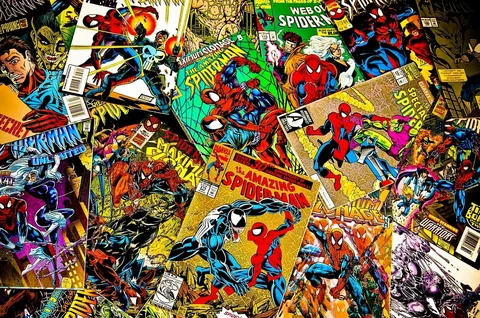The Evolution of Comics: From Print to Digital and Beyond

Introduction
Comics have long been a beloved medium for storytelling, offering a unique blend of art and narrative. Over the years, they have evolved dramatically in style, format, and audience, transitioning from simple printed strips to complex graphic novels and digital formats. This article explores the growth of comics, highlighting key developments and trends that have shaped the medium.
A Brief History of Comics
The Early Days: Origins and Strips
The roots of comics can be traced back to the 19th century, with early examples found in caricatures and satirical illustrations. The first recognized comic strip, "The Yellow Kid," debuted in 1895, marking a pivotal moment in the medium's history. By the early 20th century, comics began appearing regularly in newspapers, with characters like Popeye and Little Orphan Annie gaining widespread popularity.
The Golden Age: Superheroes Emerge
The late 1930s and 1940s are often referred to as the Golden Age of comics, primarily due to the rise of superhero characters. Iconic figures like Superman (1938) and Batman (1939) captured the imaginations of readers, leading to the proliferation of superhero comics. This era also saw the establishment of major publishers like DC and Marvel, which would become titans of the industry.
The Silver Age: Expanding Horizons
The 1960s marked the Silver Age of comics, characterized by a shift towards more complex storytelling and character development. Marvel, under the guidance of writers like Stan Lee and artists like Jack Kirby, introduced flawed, relatable heroes such as Spider-Man and the X-Men. This era also saw the emergence of genre diversity, including horror, fantasy, and science fiction comics.
The Modern Age: Graphic Novels and Indie Comics
The Rise of the Graphic Novel
By the late 20th century, comics began to be recognized as a serious art form. The publication of works like Art Spiegelman’s "Maus" (1991) and Alan Moore’s "Watchmen" (1986) helped elevate the medium, showcasing its potential for deep storytelling and artistic expression. This led to the growth of the graphic novel format, allowing for longer, more intricate narratives.
The Indie Movement
The 1990s and 2000s saw a surge in independent and self-published comics. Creators like Jeff Smith ("Bone") and David Boring introduced innovative storytelling styles, while the rise of small press publishers provided a platform for diverse voices. Webcomics also emerged, democratizing the medium and allowing creators to reach audiences directly without traditional publishing constraints.
The Digital Revolution
Comics Online
The 21st century has witnessed a significant shift towards digital comics. Platforms like ComiXology and Webtoon have transformed how readers access comics, offering vast libraries at their fingertips. Digital comics also allow for unique interactive experiences, integrating animations and sound in ways print cannot.
Social Media and Fandom
Social media has played a pivotal role in the growth of comics, enabling creators to connect with fans, share their work, and build communities. Platforms like Instagram and Twitter have become vital for emerging artists, allowing them to showcase their talent and gain recognition.
Current Trends in Comics
Diverse Narratives
Today, comics are more diverse than ever. Creators from various backgrounds are telling stories that reflect a broader range of experiences and identities. This inclusivity has enriched the medium, bringing new perspectives and themes to the forefront.
Merging Mediums
The lines between comics and other forms of media are increasingly blurred. Adaptations into films, television series, and video games have propelled comic characters into mainstream culture. Franchises like the Marvel Cinematic Universe have brought comic stories to new audiences, further popularizing the medium.
The Rise of Manga
Manga, or Japanese comics, has seen a significant rise in global popularity. Titles like "My Hero Academia" and "Attack on Titan" have captivated readers worldwide, influencing styles and storytelling techniques in Western comics. This cross-cultural exchange continues to enrich the comic landscape.
Conclusion
From their humble beginnings in newspaper strips to their current status as a respected art form, comics have undergone a remarkable transformation. As they continue to evolve, embracing new technologies and diverse voices, the future of comics looks bright. Whether in print or digital formats, comics will undoubtedly remain a powerful medium for storytelling, creativity, and cultural expression for years to come.
- Arts
- Business
- Computers
- Games
- Health
- Home
- Kids and Teens
- Money
- News
- Recreation
- Reference
- Regional
- Science
- Shopping
- Society
- Sports
- Бизнес
- Деньги
- Дом
- Досуг
- Здоровье
- Игры
- Искусство
- Источники информации
- Компьютеры
- Наука
- Новости и СМИ
- Общество
- Покупки
- Спорт
- Страны и регионы
- World


